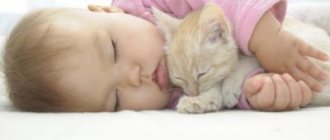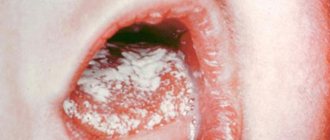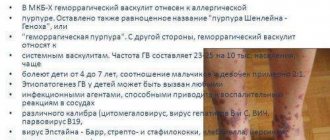Children often catch colds because their immune systems are still developing. At the same time, in weakened children, colds are often severe, with sleepless nights and the subsequent development of complications. How to treat a child, what symptoms accompany the disease and what modern remedies for ARVI for children does the pharmaceutical industry offer?
- Characteristic signs of a cold
- How to treat a cold with the main symptoms: With a cough
- For a sore throat
- For a stuffy nose
Few parents are not familiar with acute respiratory viral infection (ARVI) in children, which manifests itself as catarrhal inflammation of the upper respiratory tract and occurs with fever, sneezing, coughing, sore throat and disturbance of the general condition of varying severity. As a rule, preschoolers and schoolchildren infect each other in kindergartens and schools, bring the disease home, “share” the infection with adults - and so everything continues in a circle. Adults experience an average of two to five cold episodes per year, and children experience up to ten. Infants usually get sick less often, however, if there is an older child in the family, he can infect the baby every time.
According to statistics, in preschool institutions the incidence of illness is especially high in the first or second year of attendance, but doctors note that now those children who do not attend kindergarten often get sick. As for the causes of the development of the disease, according to pediatricians, neither hypothermia, nor drafts, nor wet feet can themselves cause ARVI. However, in autumn and winter, cold reduces local immunity, opening the way for pathogens. For this reason, disease outbreaks usually occur from September.
Characteristic signs of a cold
Parents should be wary if the child becomes capricious for no reason and shows anxiety, refuses food, looks sleepy, apathetic, and the usual games and favorite toys do not arouse his interest. All this can signal an impending illness. Colds in children can be viral or bacterial. It is very difficult to distinguish them by external signs and symptoms, without laboratory tests. In addition, a viral infection is often accompanied by a bacterial infection over time.
To correctly draw up a treatment program, pediatricians always take into account the severity of symptoms. The disease can manifest itself with the following signs:
- Increased body temperature. This is due to the effect of pathogens and their toxins on the thermoregulation center located in the hypothalamus, a region of the brain that regulates all life processes. The severity of the temperature reaction depends on the state of the child’s immune system. In some children, the temperature during ARVI does not exceed 37-38 0C, while in others it rises much higher.
- Nasal congestion, runny nose. When a child has a cold, this symptom develops due to swelling and inflammation of the nasal mucosa, followed by the release of mucus. If the disease is caused by viruses, the discharge is viscous and transparent. And when bacteria attach, the mucus becomes yellow-green.
- General intoxication of the body. Due to the effects of toxins on the body, the child feels weakness, lethargy, muscle pain, nausea, and enlarged lymph nodes. There is redness of the skin of the face and neck.
- Sore and sore throat. In addition to unpleasant sensations in the throat, if a child’s oropharynx is affected, the arches, tonsils, and back wall may turn red. A whitish coating may form on the surface of the tonsils.
- Headache. They can be felt only in the area of the temples, forehead, or be diffuse, which is observed at elevated temperatures. With complications of a cold such as sinusitis, frontal sinusitis and sinusitis, headaches may intensify.
- Cough. With ARVI, the cough can be wet, dry without sputum, or wet with sputum production.
In rare cases, ARVI and colds in a child can lead to the appearance of a rash and pinpoint small hemorrhages on the body.
How to examine a baby's throat and make a diagnosis?
A red throat in a baby can indicate various problems. First of all, it is necessary to assess the nature of the redness. You should look at the throat, because even a person without medical education can confirm the presence of the disease (we recommend reading: how to properly look at a child’s throat at home?). A healthy throat in both an adult and a child will be a soft pink color. Redness of the mucous membrane or at least a slight change in color indicates that the child, if not in pain, is unpleasant, and the disease needs to be treated.
- How to treat a red sore throat in a baby: syrups and folk remedies for a child under one year old
A sick newborn sleeps poorly and eats less. Swallowing becomes more frequent. The baby cries more often, stronger and shriller than usual, and calms down only when feeding. To check the throat, you need to arm yourself with an inspection stick or cutlery with a flat handle. Otherwise, you won’t be able to see anything, because the child will cover the mucous membrane with his tongue.
Sometimes you can understand the nature of the disease and treat the child at home, but a number of symptoms require an immediate call to the doctor:
- refusal to breastfeed when the throat hurts so much that the child cannot eat;
- there is a lot of plaque on the mucous membrane or tonsils;
- the child chokes with a strong cough;
- strong wheezing is heard in the lungs;
- after the throat, the arms, lower back, and legs begin to ache;
- symptoms do not subside within a week.
INTERESTING: what to do if a child coughs a lot when sleeping?
If, in addition to a sore throat, your child has other symptoms, such as coughing, then you should immediately consult a doctor.
Pain in the back and legs indicates severe intoxication of the body, and wheezing can warn of pneumonia. Consulting a doctor would be appropriate even for mild cold symptoms. It is still better to hospitalize an infant immediately.
READ ALSO: Infant hoarseness: causes and treatment
When does a child need to see a doctor?
Despite the fact that many parents do not turn to specialists if their son or daughter has ARVI, this disease can lead to various complications, even life-threatening for the baby. ARVI is especially dangerous for newborns and children under one year old.
You should immediately contact your pediatrician if your baby has the following conditions:
- temperature 38 0C in children in the first 3 months of life;
- increase in body temperature up to 40⁰C in a child of any age;
- complaints of ear pain;
- vomiting, abdominal pain;
- the baby refuses to drink and urinates little;
- very severe headaches, constant crying;
- neck muscle tension;
- labored breathing.
If the child’s elevated body temperature does not decrease within several days and no improvement is observed 5-7 days after the onset of the disease, this is also a reason to seek medical help without self-medicating.
Treatment
To determine how to treat a baby’s throat, you need to show the child to the doctor. Obviously, rinsing and irrigation with conventional preparations are excluded. Sometimes, of course, doctors prescribe medications based on their own experience of using them in children under one year old, but usually medications are intended for children from three years of age. Therefore, pediatricians offer other solutions:
- A suitable preparation can be lubricated from the inside of the baby's pacifier or cheeks.
- Miramistin or Furacilin are prescribed to lubricate the tonsils directly (for this, prepare gauze swabs and carefully moisten the neck of the baby).
- In a similar way, solutions of calendula, chamomile, and sage can be applied to the tonsils. These herbs have an antiseptic effect. But first you should rule out allergies to them.
- Treatment of a baby's throat may involve lubricating the cavity with tablets dissolved in water to relieve inflammation.
Such measures are exclusively local in nature, so they often do not get rid of the root cause of redness. If we are talking about bacterial infections, for example, a sore throat, then the doctor must prescribe antibiotics.
Sore throat in an infant occurs quite rarely, but most often requires treatment in a hospital, since the baby is still very small, and the infection affects the body quite strongly. Intoxication in this case can lead to serious complications. The disease can be recognized by body temperature reaching 40 degrees, vomiting, diarrhea, and enlarged lymph nodes. In this case, there are no other symptoms of ARVI or colds - runny nose and cough.
Treatment of sore throat is carried out in the manner described above - local treatment of the throat, as well as the inclusion of antibiotics in complex therapy exclusively under the supervision of a doctor.
Treatment nuances
Considering the age of the baby, doctors offer a wide variety of treatment methods for babies. For example, in addition to irrigating the mouth and lubricating the nipples, you can use different methods and means:
- Chamomile decoction or other antiseptics can be instilled into the nose, then the drug flows down the back wall of the larynx, affecting the sore throat.
- You can also drip breast milk into the spout, which is considered a natural antiseptic.
- It is important to give your baby warm drinks that are appropriate for their age.
- The doctor may also prescribe Lymphomyosot or other drugs in drops to boost immunity and treat inflammatory processes in the oral cavity.
If there are no serious reasons for hospitalization of the baby when the throat is red, then in any case you should carefully follow the doctor’s instructions - from the dosage of medications to caring for the baby. During the recovery period, it is important to provide the baby with a healthy environment - fresh air in the room, optimal room temperature and the required level of humidity. As you know, dry, hot mucous membranes are an excellent breeding ground for bacteria, so the baby’s nose should be thoroughly moistened to prevent any infections from entering the body.
You should not overheat the baby, even if he has a cold: the baby’s skin is the largest organ, therefore, by influencing the body of the newborn, you can either improve his well-being or aggravate the situation. Common sense and attention will help you cope with any disease.
The difference between a cold and the flu
Despite the general similarity of symptoms: runny nose, fever, cough, influenza and ARVI are completely different diseases with different pathogens and methods of treatment. They also proceed in different ways.
Learn to distinguish diseases from each other:
| Well-being | ARVI | Flu |
| Body temperature | It rarely rises above 38 0C | It rises to 39 0C and above in 2-3 hours |
| Intoxication of the body | Expressed by increased fatigue | Severe chills, headache and pain when moving the eyes, photophobia, body aches |
| Runny nose and nasal congestion | Occurs in the first days | They do not appear immediately and are not so pronounced |
| Sneezing | Always present | May be missing |
| Cough, chest discomfort | Dry, choppy, appears immediately | Appears a few days after the onset of the disease |
| Sore throat and redness | Has a pronounced character | Doesn't appear right away |
| Discomfort in the eyes | Rarely, if a bacterial infection occurs | Common symptom |
Also, the difference in the symptoms of influenza and ARVI in children is the presence or, conversely, absence of gastrointestinal disorders. If a child has a cold, vomiting and loose stools are extremely rare. If you have the flu, your baby may have intestinal disorders.
How to treat a cold with a cough
To treat ARVI and subsequent relief of unpleasant symptoms, including cough, choose antiviral drugs, the instructions of which mention the admissibility of their use for the treatment of children. One of these drugs is VIFERON, which has a wide spectrum of antiviral activity. Alpha-2b interferon, which is part of this drug, is created on the basis of modern technologies, has antiviral properties (blocks virus reproduction), has immunomodulatory properties and helps restore immunity. VIFERON preparations were developed as a result of fundamental research in the field of immunology, which proved that in the presence of antioxidants (vitamins C, E and others), the antiviral effect of interferon is enhanced.
The drug VIFERON Candles (suppositories) can be used to treat children from the first days of life. Premature newborns with a gestational age of less than 34 weeks are prescribed Viferon 150,000 IU, 1 suppository 3 times a day after 8 hours every day for 5 days. According to clinical indications, therapy can be continued. The break between courses is 5 days.
Children under 7 years old, incl. newborns and premature infants with a gestational age of more than 34 weeks are prescribed VIFERON Suppositories (suppositories) 150,000 IU, 1 suppository 2 times a day after 12 hours every day for 5 days. According to clinical indications, therapy can be continued. The break between courses is 5 days.
Children over 7 years old are prescribed VIFERON 500,000 IU, 1 suppository 2 times a day every 12 hours every day for 5 days. According to clinical indications, therapy can be continued.
Since the drug VIFERON Suppositories (suppositories) has a wide spectrum of antiviral activity, it is a universal remedy against ARVI and influenza. This drug helps fight infection at any stage of the disease. VIFERON provides a powerful antiviral effect and allows you to shorten the overall duration of the disease, quickly cope with the manifestations of infection (runny nose, cough, weakness, fever, etc.), and also reduces the likelihood of developing complications and subsequent diseases1.
How to treat a cold with a sore throat
Combating a sore throat most often involves local therapy. The doctor will recommend using rinsing solutions, antiseptics, and, if necessary, aerosol sprays that are sprayed in the oral cavity. Children over three years of age can be given lozenges because, for example, a 2-year-old child with a cold may not understand how to use the medicine. Antiviral drugs will help you quickly remove the virus from the body and begin to recover. Also, hot and cold inhalations, rinses and be sure to drink plenty of warm tea or unsweetened compote are suitable for babies.
In addition, you may need to take antihistamines (for example, for laryngitis). If complications occur in the lungs and bronchi, the pediatrician will recommend antibiotics. However, remember that any treatment for a child’s cough, including the use of herbal decoctions, ointments for colds, compresses, various warming treatments and any other traditional medicine recipes must be agreed with the attending physician. Only he will be able to select the right therapy, taking into account the baby’s age, his medical history, the presence or absence of allergies to various drugs and other important nuances, which will ultimately help cure the little patient.
How to treat a cold with a stuffy nose
Rhinitis (inflammation syndrome of the nasal mucosa) is one of the most common symptoms of ARVI, which in young children may be accompanied by a high risk of complications. If the child cannot blow his nose himself, it is necessary to help the baby by sucking out the mucus using a special nasal aspirator, or using a clean small syringe.
The clinical picture of acute rhinitis is usually divided into three stages. The dry prodromal stage makes itself felt by the general symptoms of the disease, itching in the nose, burning sensation and dryness. The catarrhal stage is characterized by the appearance of watery discharge from the nose, loss of smell, lacrimation, obstruction of the nasal passages, and a change in the child’s voice. After a few days, the disease enters the mucous stage, when local symptoms gradually regress. The persistence of nasal congestion for more than ten days, deterioration of the child’s condition, the appearance of pain in the face and purulent nasal discharge may indicate the development of bacterial rhinosinusitis.
For the treatment of acute rhinitis and bacterial rhinosinusitis, you can use VIFERON Gel. This drug can be used to treat children from the first days of life. It is necessary to apply a strip of gel approximately 0.5 cm long to the nasal mucosa 3-5 times a day for 5 days. Before this, it is better to rinse the mucous membrane with saline solution. In order to protect a child from ARVI, it is necessary to apply a strip of gel approximately 0.5 cm long to the nasal mucosa 2 times a day as a preventive measure. Course duration is 2-4 weeks.
For the treatment of ARVI in children from 1 to 2 years old, VIFERON Ointment 2500 IU (1 pea with a diameter of 0.5 cm) 3 times a day is also used, in children from 2 to 12 years old - ointment 2500 IU (1 pea with a diameter 0.5 cm) 4 times a day, for children from 12 to 18 years old - ointment 5000 IU (1 pea with a diameter of 1 cm) 4 times a day. The duration of treatment is 5 days.
Reference and information material
Author of the article
Belyaev Dmitry Alexandrovich
General doctor
- Nesterova I.V. “Interferon drugs in clinical practice: when and how,” “Attending Physician,” September 2021.
Loading...
Take other surveys
How to treat a sore throat in a baby?
Young parents should remember that a viral infection is accompanied by a runny nose, red sore throat and fever, while a bacterial infection usually affects only the throat.
ARVI can be cured at home, but bacterial infections (in particular, sore throat) most often require consultation with a doctor and hospitalization. READ ALSO: what to do if a child has a red throat, but does not hurt?
A viral infection is usually suppressed with medications, but the main medicine is immunity. The body produces a protein (interferon) and fights itself. Any auxiliary medications for an infant under 1 month can only be prescribed by a doctor and only for acute symptoms. For mild forms of bacterial infection, it is enough to create comfortable conditions for the child.
When a red throat is accompanied by a runny nose, the first thing to do is clear your nose. This measure will eliminate microbes and prevent their proliferation. It is necessary to remove not only thick, but also dry accumulations. It is impossible to treat inflammation in an infant with sprays, so you need to pour in the solution with a pipette.
A runny nose is the first thing that needs to be treated when an infant has a cold, since if the nose is stuffy, treating the throat will be difficult
The air in the bedroom should have an average temperature of 18 to 20ºС and humidity within 50-70%. You can humidify the air with a spray bottle, hang wet towels, and wash the floor. In cold weather, it is impossible to humidify the air with an open window. Cold air from the street will only dry out the indoor air. In winter, humidity is regulated by the temperature of the battery.
It is not recommended to cause sweating with warm clothing. The best cure for infection is water. It is necessary to give the newborn warm water and decoctions. Raisin decoction is suitable for babies. Compote and tea are recommended for older children. The liquid moisturizes dry mucous membranes and relieves pain.
There is no need to stop breastfeeding, even if your baby is less enthusiastic than usual. However, you cannot force him. Weight loss during illness is quite natural and will be regained within a few days of recovery. Breastfeeding will help calm your baby. Mom’s presence in itself is healing.
Sick children especially need healthy nutrition during treatment, so breastfeeding should not be stopped.
Medication recommendations
It is possible to treat a red throat in an infant under 1 month of age only with a limited number of medications. For severe pain, you can crush Paracetamol or Ibuprofen and give it to the child in small quantities. You can lubricate the pacifier with syrup or a solution diluted with water (Chlorophyllipt, Lugol or Miramistin). It is allowed to give the baby chamomile tea (0.5 teaspoon with warm water).
Bacterial infections are accompanied by more complex symptoms and more often lead to complications. You may need antibiotics, which are taken only under medical supervision (ceftriaxone).









